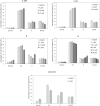Revisiting the anticancer properties of phosphane(9-ribosylpurine-6-thiolato)gold(I) complexes and their 9H-purine precursors
- PMID: 36244017
- PMCID: PMC9653339
- DOI: 10.1007/s00775-022-01968-x
Revisiting the anticancer properties of phosphane(9-ribosylpurine-6-thiolato)gold(I) complexes and their 9H-purine precursors
Abstract
New mono- and di-nuclear thio-purine and thio-purine nucleoside gold(I) complexes were synthesized, characterized, and evaluated in vitro for biological activities in comparison to related known purine complexes. By combining known anti-tumoral thio-purines with R3PAu moieties as present in auranofin, complexes with enhanced effects and selectivities were obtained, which not only act as cytostatics, but also disrupt tumor-specific processes. Their IC50 values in cytotoxicity test with tumor cell lines ranged from three-digit nanomolar to single-digit micromolar, revealing a tentative structure-activity relationship (SAR). Both the residues R2 of the phosphane ligand and R1 at C2 of the pyrimidine ring had a significant impact on the cytotoxicity. In most cases, the introduction of a ribo-furanosyl group at N9 of the purine led to a distinctly more cytotoxic complex. Most complexes were more active against multi-drug-resistant tumor cells or such lacking functional p53 when compared to the respective untreated wild type cell lines. Some nucleoside complexes displayed an interesting dose-dependent dual mode of action regarding cell cycle arrest and DNA repair mechanism. Some phosphane(purine-6-thiolato)gold (I) complexes had a stronger inhibitory effect on the thioredoxin reductase (TrxR) and on the reactive oxygen species (ROS) generation in cancer cells than is typical of other gold complexes. They also led to DNA fragmentation and showed anti-angiogenic effects. Their stability under test conditions was demonstrated by 77Se NMR monitoring of an exemplary selenopurine complex.
Keywords: Anticancer compounds; Auranofin; Gold(I) complexes; Nucleosides; Thioredoxin reductase (TrxR) inhibitors; Triorganophosphanes.
© 2022. The Author(s).
Conflict of interest statement
There are no conflicts of interest.
Figures







Similar articles
-
Gold(I) thiotetrazolates as thioredoxin reductase inhibitors and antiproliferative agents.Dalton Trans. 2015 Jan 21;44(3):1161-9. doi: 10.1039/c4dt03105a. Dalton Trans. 2015. PMID: 25413270
-
Gold(I) carbene complexes causing thioredoxin 1 and thioredoxin 2 oxidation as potential anticancer agents.J Med Chem. 2012 Jun 14;55(11):5518-28. doi: 10.1021/jm300428v. Epub 2012 Jun 4. J Med Chem. 2012. PMID: 22621714
-
Bimetallic titanocene-gold phosphane complexes inhibit invasion, metastasis, and angiogenesis-associated signaling molecules in renal cancer.Eur J Med Chem. 2019 Jan 1;161:310-322. doi: 10.1016/j.ejmech.2018.10.034. Epub 2018 Oct 17. Eur J Med Chem. 2019. PMID: 30368130 Free PMC article.
-
Recent development of gold(I) and gold(III) complexes as therapeutic agents for cancer diseases.Chem Soc Rev. 2022 Jul 4;51(13):5518-5556. doi: 10.1039/d1cs00933h. Chem Soc Rev. 2022. PMID: 35699475 Review.
-
Chemistry, structure, and biological roles of Au-NHC complexes as TrxR inhibitors.Bioorg Chem. 2020 Jan;95:103552. doi: 10.1016/j.bioorg.2019.103552. Epub 2019 Dec 24. Bioorg Chem. 2020. PMID: 31911299 Review.
Cited by
-
Exploring a Therapeutic Gold Mine: The Antifungal Potential of the Gold-Based Antirheumatic Drug Auranofin.Int J Mol Sci. 2025 Aug 16;26(16):7909. doi: 10.3390/ijms26167909. Int J Mol Sci. 2025. PMID: 40869230 Free PMC article. Review.
-
Palladium and Platinum Complexes of the Antimetabolite Fludarabine with Vastly Enhanced Selectivity for Tumour over Non-Malignant Cells.Molecules. 2023 Jul 2;28(13):5173. doi: 10.3390/molecules28135173. Molecules. 2023. PMID: 37446835 Free PMC article.
-
New 4,5-Diarylimidazol-2-ylidene-iodidogold(I) Complexes with High Activity against Esophageal Adenocarcinoma Cells.Int J Mol Sci. 2023 Mar 17;24(6):5738. doi: 10.3390/ijms24065738. Int J Mol Sci. 2023. PMID: 36982817 Free PMC article.
-
Gold(I) Complexes Based on Nonsteroidal Anti-Inflammatory Derivatives as Multi-Target Drugs against Colon Cancer.Inorg Chem. 2024 Oct 21;63(42):19769-19782. doi: 10.1021/acs.inorgchem.4c02988. Epub 2024 Oct 10. Inorg Chem. 2024. PMID: 39389034 Free PMC article.
References
-
- Ott I, Gust R. Non platinum metal complexes as anti-cancer drugs. Arch Pharm. 2007;340:117–126. - PubMed
-
- Bernhard GC. Auranofin therapy in rheumatoid arthritis. J Lab Clin Med. 1982;100:167–177. - PubMed
-
- Raninga PV, Lee AC, Sinha D, Shik Y-Y, Mittal D, Makhale A, et al. Therapeutic cooperation between auranofin, a thioredoxin reductase inhibitor and anti-PD-L1 antibody for treatment of triple-negative breast cancer. Int J Cancer. 2020;146:123–136. - PubMed
Publication types
MeSH terms
Substances
LinkOut - more resources
Full Text Sources
Research Materials
Miscellaneous

